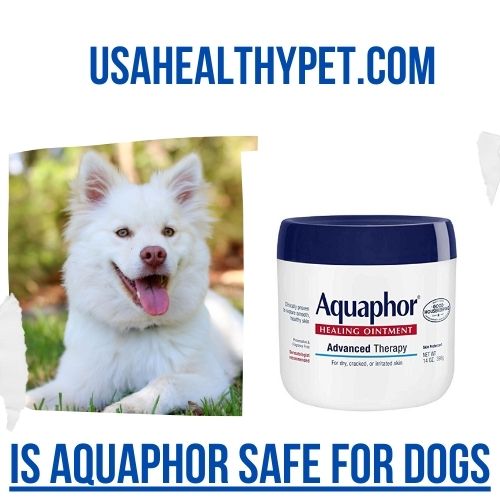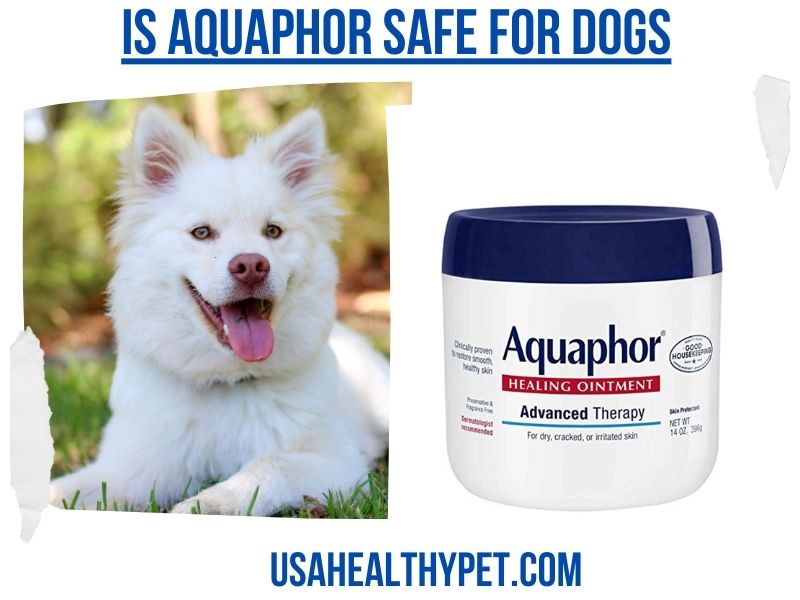You might be wondering, “Is Aquaphor safe for dogs?” Well, you’re not alone in your curiosity! Aquaphor is a popular skincare product many people use for various skin issues, from dry patches to minor cuts.
But here’s the exciting part: you can use it on your dog too! Whether it’s for soothing dry paws, healing minor cuts, or calming irritated skin, Aquaphor can be a handy addition to your pet care routine.
The good news is that Aquaphor is generally safe for dogs because it’s made with non-toxic ingredients. However, it’s important to start with a small amount and keep an eye on your furry friend for any signs of an upset stomach or allergic reaction.
If your dog happens to lick off a bit of Aquaphor, don’t worry! Just monitor them closely. If you notice any unusual symptoms or if things don’t seem to be improving, it’s best to consult your vet.
- What is Aquaphor?
- Common Uses of Aquaphor
- Why Pet Owners Consider Aquaphor
- Is Aquaphor Safe for Dogs?
- When Should You Use Aquaphor on Your Dog?
- How to Apply Aquaphor on Dogs
- Potential Side Effects of Aquaphor on Dogs
- What to Do If Your Dog Ingests Aquaphor
- Alternatives to Aquaphor for Dogs
- Tips for Using Topical Treatments on Dogs
- Natural Remedies for Dog Skin Issues
- Consulting Your Veterinarian
- Precautions to Take with Any Topical Product
- Conclusion
- FAQs
What is Aquaphor?
Aquaphor is a popular over-the-counter ointment used primarily to protect and heal skin. It’s often used by humans for dry, cracked skin, minor cuts, burns, and even diaper rash.
Its key ingredients include petrolatum, mineral oil, ceresin, and lanolin alcohol, which help to moisturize and protect the skin.
Common Uses of Aquaphor
Aquaphor is versatile and can be used for a variety of skin issues. Here are some common uses:
For Humans
- Dry Skin: Provides intense moisture for dry, cracked skin.
- Cuts and Scrapes: Protects minor cuts and scrapes to aid in healing.
- Burns: Helps soothe and protect minor burns.
- Tattoo Aftercare: Often recommended for keeping new tattoos moisturized.
- Diaper Rash: Prevents and heals diaper rash in babies.
For Dogs
- Dry Paws: Moisturizes and protects dry, cracked paws.
- Hot Spots: Soothes irritated skin spots.
- Minor Cuts and Scrapes: Protects and aids in the healing process.
- Dry Noses: Keeps dry, cracked noses moisturized.
Why Pet Owners Consider Aquaphor
As a pet owner, it’s natural to seek out products that can help soothe and heal your dog’s skin issues.
Aquaphor is a product many people already have at home, making it a convenient option. But convenience aside, the big question remains: Is it safe for dogs?
Is Aquaphor Safe for Dogs?
The short answer is yes, Aquaphor is generally safe for dogs. However, there are a few things to keep in mind to ensure your dog’s safety.
Characteristics
| Characteristics | Values |
|---|---|
| Brand Name | Aquaphor |
| Purpose | Skincare |
| Suitable for | Humans, Not recommended for dogs |
| Ingredients | Petrolatum, Mineral oil, Ceresin, Lanolin, Alcohol, Panthenol, and Glycerin |
| Safety Warnings | Avoid contact with eyes, for external use only, keep out of reach of children |
| Usage | Apply a thin layer to the affected area |
| Benefits | Moisturizes and protects skin, soothes dryness and minor skin irritations |
| Potential Risks | Avoid contact with eyes, for external use only, and keep out of reach of children |
| Alternative | Veterinary-approved pet creams or ointments |
Ingredients and Safety
Most of the ingredients in Aquaphor are considered safe for dogs. Petrolatum and mineral oil, for example, are commonly found in pet-safe products. However, you should always monitor your dog for any adverse reactions.
Veterinarian Advice
It’s always a good idea to consult your veterinarian before applying any new product to your dog’s skin. Your vet can provide specific advice based on your dog’s health and skin condition.

When Should You Use Aquaphor on Your Dog?
There are several situations where using Aquaphor on your dog might be beneficial:
Dry Paws
If your dog has dry, cracked paws, applying a small amount of Aquaphor can help moisturize and protect them.
Hot Spots
Hot spots are areas of irritated skin that can become red and inflamed. Aquaphor can help soothe these spots and promote healing.
Minor Cuts and Scrapes
For minor cuts and scrapes, Aquaphor can provide a protective barrier, keeping the area moisturized and aiding in the healing process.
Dry Nose
A dry, cracked nose can be uncomfortable for your dog. A little Aquaphor can help keep it moisturized.
How to Apply Aquaphor on Dogs
Applying Aquaphor to your dog is relatively simple, but there are a few tips to ensure it’s done safely and effectively:
- Clean the Area: Before applying Aquaphor, clean the affected area with mild soap and water.
- Dry the Area: Make sure the area is dry before application.
- Apply a Thin Layer: Use a small amount of Aquaphor and spread it evenly over the affected area.
- Prevent Licking: Keep an eye on your dog to prevent them from licking the area. You may need to use a cone or distraction to keep them from licking it off.
Potential Side Effects of Aquaphor on Dogs
While Aquaphor is generally safe, there are potential side effects to be aware of:
Allergic Reactions
Some dogs may be allergic to one or more of the ingredients in Aquaphor. Watch for signs of an allergic reaction, such as redness, swelling, or itching.
Gastrointestinal Upset
If your dog ingests a large amount of Aquaphor, it could cause gastrointestinal upset, including vomiting and diarrhea. This is why it’s important to prevent your dog from licking the treated area.
What to Do If Your Dog Ingests Aquaphor
If your dog manages to ingest Aquaphor, don’t panic. In most cases, small amounts are not harmful. However, if your dog ingests a large amount, you should contact your veterinarian for advice.
Signs to Watch For
- Vomiting
- Diarrhea
- Lethargy
- Loss of appetite
If you notice any of these symptoms, seek veterinary care immediately.
Alternatives to Aquaphor for Dogs
While Aquaphor can be a good option, there are other alternatives that you might consider:
Pet-Specific Products
There are many products designed specifically for pets that might be more suitable. These include paw balms, skin soothers, and ointments formulated for dogs.
Natural Remedies
Natural remedies, such as coconut oil or aloe vera, can also be effective for treating dry skin, paws, and minor irritations.
Tips for Using Topical Treatments on Dogs
Using topical treatments on dogs requires some care and attention:
Choose Pet-Safe Products
Always choose products that are labeled as safe for pets. Avoid using human products unless specifically recommended by your vet.
Monitor Your Dog
Keep an eye on your dog after applying any topical treatment to ensure they don’t have an adverse reaction.
Prevent Licking
Try to prevent your dog from licking the treated area by using a cone or distraction techniques.
Natural Remedies for Dog Skin Issues
If you prefer natural remedies, here are a few options that can help with your dog’s skin issues:
Coconut Oil
Coconut oil is a natural moisturizer that can help with dry skin and paws. Simply apply a small amount to the affected area.
Aloe Vera
Aloe vera has soothing properties that can help with hot spots and minor irritations. Make sure to use pure aloe vera gel without added ingredients.
Oatmeal Baths
Oatmeal baths can help soothe itchy, irritated skin. Simply grind oatmeal into a powder and add it to your dog’s bath.
Consulting Your Veterinarian
Before using any new product on your dog, it’s always best to consult your veterinarian. They can provide personalized advice based on your dog’s specific needs and health conditions.
Regular Check-Ups
Regular veterinary check-ups can help catch skin issues early and provide you with the best treatment options.
Expert Advice
Your vet can recommend the most effective and safest treatments for your dog’s skin issues.
Precautions to Take with Any Topical Product
When using any topical product on your dog, take the following precautions:
Patch Test
Always do a patch test before applying a new product to a larger area. Apply a small amount to a small area of skin and watch for any adverse reactions.
Avoid Eyes and Mucous Membranes
Keep the product away from your dog’s eyes and mucous membranes to prevent irritation.
Follow Instructions
Always follow the product instructions and your vet’s recommendations for use.
Conclusion
So, is Aquaphor safe for dogs? Generally, yes, it is safe when used correctly. It’s a versatile product that can help with dry skin, minor cuts, and other minor skin issues.
However, it’s important to use it carefully, monitor your dog for any adverse reactions, and consult your veterinarian if you have any concerns. By taking these steps, you can help ensure your dog’s skin stays healthy and comfortable.
FAQs
1. Can I use Aquaphor on my dog’s paws?
Yes, Aquaphor can be used to moisturize and protect your dog’s dry, cracked paws.
2. Is Aquaphor safe for my dog to lick?
While small amounts are generally not harmful, it’s best to prevent your dog from licking the treated area to avoid gastrointestinal upset.
3. What should I do if my dog has an allergic reaction to Aquaphor?
If your dog shows signs of an allergic reaction, such as redness, swelling, or itching, stop using Aquaphor and consult your veterinarian.
4. Are there any natural alternatives to Aquaphor for my dog?
Yes, natural remedies like coconut oil and aloe vera can be effective for treating dry skin and minor irritations.
5. Should I consult my vet before using Aquaphor on my dog?
Yes, it’s always a good idea to consult your veterinarian before using any new product on your dog to ensure it’s safe and appropriate for their specific needs.
